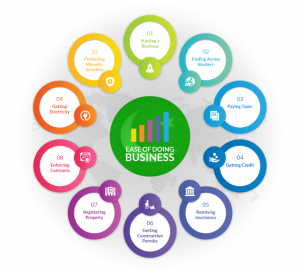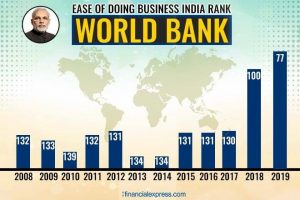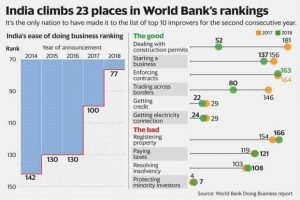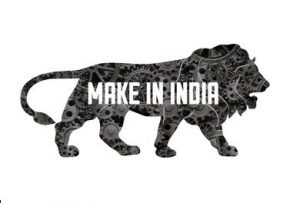All of us must be aware of the “Ease of doing business”. It is an index published yearly by the World Bank which defines the ease of doing business in a country. It was created by Simeon Djankov. The Ease of Doing Business (EoDB) index is a ranking system established by the World Bank Group. In the EODB index, ‘higher rankings’ (a lower numerical value) indicate better, usually simpler, regulations for businesses and stronger protections of property rights. A nation’s ranking on the index is based on the average of 12 sub-indices:
1. Starting a Business of all
2. Dealing with Construction Permits
3. Getting Electricity
4. Registering Property
5. Getting Credit
6. Protecting Minority Investors
7. Paying Taxes
8. Trading across Borders
9. Enforcing Contracts
10. Resolving Insolvency
11. Employing workers
12. Contracting with the government
Start an Industry in Andhra Pradesh (AP), Click Here
Start an Industry in Arunachal Pradesh, Click Here

Among the chosen 190 countries, India ranked 63rd in Doing Business 2020: World Bank Report. In 2014, the Government of India launched an ambitious program of regulatory reforms aimed at making it easier to do business in India. The program represents a great deal of effort to create a more business-friendly environment.
Start an Industry in Assam, Click Here
Start an Industry in Bihar, Click Here
India has emerged as one of the most attractive destinations not only for investments but also for doing business. India jumps 79 positions from 142nd (2014) to 63rd (2019) in 'World Bank's Ease of Doing Business Ranking 2020.

Construction Permits:
In this category, India has improved from 184 in 2014 to 27 in 2019. This improvement is largely due to a reduction in the number of procedures and the time it takes to secure construction licences in India.
Start an Industry in Chandigarh, Click Here
Start an Industry in Chhattisgarh, Click Here
Getting Electricity:
In this category, India has improved from 137 in 2014 to 22 in 2019. In India, obtaining an electrical connection takes only 53 days and four procedures.
Apart from these considerable advances, India is ranked 13th in Protecting Minority Investors and 25th in Getting Credit among the 190 economies.
Central Government Initiatives Accomplished
On March 24, 2021, Finance Minister Nirmala Sitharaman announced that the Finance Bill, 2021, contains some revisions targeted at reducing compliance and boosting ease of doing business. In response to a Rajya Sabha debate on the Finance Bill, 2021, the Minister stated that there will be no tax increases, particularly in direct taxes and income tax.
Start an Industry in Dadra and Nagar Haveli and Daman and Diu, Click Here
Start an Industry in Delhi, Click Here

“The Finance Bill, 2021 doesn’t envisage any increase in taxation particularly in direct taxes and income tax. It has some amendments towards achieving a reduction in compliance aimed at ease of doing business. An approach is similar for customs and indirect taxes,” she said.
Start an Industry in Goa, Click Here
Start an Industry in Gujarat, Click Here
On March 23, 2021, the Lok Sabha passed the Finance Bill, 2021. The bill gives effect to the federal government's financial proposals for the fiscal year 2021-22. The budgetary process comes to a close with the passage of the Finance Bill by Parliament.
India has identified 6,000 costly compliances, both at the national and state levels that would be simplified as part of the government's goal to make it easier to do business in India. “A systematic exercise is being performed throughout the Centre and states to eliminate or decrease compliances that have a negative impact on business time and cost,” Guruprasad Mohapatra, secretary of the Department for Promotion of Industry and Internal Trade.
According to Mohapatra, the five ministries with the biggest compliance requirements are commerce and industry, finance, health, corporate affairs, and mines.
Start an Industry in Haryana, Click Here
Start an Industry in Himachal Pradesh, Click Here
1,500-2,000 of the 6,000 compliances are at the federal level, with the rest at the state level. There would be two stages to the exercise.
In Phase I, he said, work is being done to reduce regulatory burden in six areas, including renewing licences, assigning inspections at random, standardising returns/filings, and digitising and simplifying all manual records or procedures. According to Mohapatra, the five ministries with the biggest compliance requirements are commerce and industry, finance, health, corporate affairs, and mines.
Start an Industry in Jammu and Kashmir, Click Here
Start an Industry in Jharkhand, Click Here

According to him, the focus in Phase II would be on four areas: decriminalisation of regulations, identification and repeal of antiquated laws and norms, and extensive use of new-age digital technology. According to Mohapatra, the government is focusing on creating a single-window system for approvals and certifications in order to encourage investment. By April 15, 2021, it plans to implement the system with 14 states.
Start an Industry in Karnataka, Click Here
Start an Industry in Kerala, Click Here
Start an Industry in Ladakh, Click Here
Single-window system: -
The single-window system gateway will unify the numerous federal and state departments' existing clearance processes. Approvals of FDI in response to a question on whether the government is processing pending foreign direct investment bids from countries that share a land border with India, Mohapatra stated that the government has not barred or restricted investments from those countries. “Some plans are getting approved,” he added, adding that the approval process was left up to the appropriate ministries.
Regulations: -
Regulatory burden has a substantial impact on a company's performance. Regulations impose both time and cost to maintain compliance, and they have an impact on corporate competitiveness. Regulations are a crucial instrument for ensuring that markets operate efficiently and that their participants are trustworthy.
Start an Industry in Lakshadweep, Click Here
Start an Industry in Madhya Pradesh, Click Here
Start an Industry in Maharashtra, Click Here

They bring in the bare minimum of acceptability and allow markets to function. The government's position is that regulations should be as short as possible in terms of time and expense. Because there is a low regulatory burden, entrepreneurs may devote their time to profitable activity.
Start an Industry in Manipur, Click Here
Start an Industry in Meghalaya, Click Here
Start an Industry in Mizoram, Click Here
Since 2014, the Indian government has been working to create a more favourable climate by streamlining existing regulations and processes and removing needless requirements and procedures. In order to assist businesses in growing, the delivery of government services has been upgraded in various areas.
Through active interactions with state governments, a systematic plan of regulatory changes is being implemented not only in the Central Government's Ministries/Departments, but also in the States.
India's ranking on the World Bank's Doing Business Report (DBR) of 190 nations has risen from 142nd in 2014 to 63rd in 2020 as a consequence of the efforts. For the third year in a row, it has been ranked among the world's top ten improvers.
The focus presently, in terms of ease of doing business, is on reducing compliance burden through the use of technology, third-party assessment, and faceless human interaction. Since 2003, the World Bank Group has been evaluating economies based on the current regulatory environment using ten parameters and publishing its findings in the Doing Business Report (DBR).
Start an Industry in Nagaland, Click Here
Start an Industry in Odisha, Click Here
Start an Industry in Puducherry (Pondicherry), Click Here
Past Scenario: -
During the period 2010-14, India's ranking on (EoDB) fluctuated between 131 and 142. The government made very little effort to engage with key stakeholders and develop a plan to improve the country's ranking.
Prior to 2014, India accepted the World Bank's EoDB country rankings as an annual academic exercise, with no specific plan to improve performance on the variables that were re legating our country's comparative standing.
Start an Industry in Punjab, Click Here
Start an Industry in Rajasthan, Click Here

India scored poorly in areas such as cross-border trade, starting a business, obtaining building licences, resolving insolvency, and enforcing contracts.
The government's half-hearted efforts to address the difficulties were not yielding major achievements, or, conversely, the moves taken by other countries were significant enough to be acknowledged in the ranking system.
Start an Industry in Sikkim, Click Here
Start an Industry in Tamil Nadu, Click Here
As a result, India's position among the 190 countries remained unchanged, falling into the lowest 25% to 30% of the countries.
Present Scenario: -
The current government has strengthened the existing business regulatory environment in order to meet the Prime Minister's aim of getting India into the top 50 countries in the Doing Business rankings.
To further understand global best practises, an examination of major similar countries was conducted.
Start an Industry in Telangana, Click Here
Start an Industry in Tripura, Click Here
Seven Ministries/Departments were designated as nodal Ministries/Departments across ten indicators, according to a comprehensive strategy (roadmap).

Since 2014, the goal has been to streamline existing regulations and processes while reducing extraneous requirements and procedures in order to create a more hospitable business environment.
The World Bank's Ease of Doing Business project, the State and District Reform Action Plan, and a systematic strategy to reduce regulatory compliance burden on firms are all being explored.
Technology has been regarded as the primary driver of efficiency gains. After an extensive Government Process Re-engineering exercise to give seamless services to businesses, the Central and State governments have adopted a slew of regulatory reforms.
Start an Industry in Uttar Pradesh, Click Here
Start an Industry in Uttarakhand, Click Here
Start an Industry in West Bengal, Click Here
Conclusion: -
NIIR PROJECT CONSULTANCY SERVICES (NPCS), an ISO 9001:2015 company is one of the leading reliable names in industrial world for providing one of the most comprehensive suites of technical consulting services. We at NPCS are dedicated with passion and enthusiasm for helping young entrepreneurs is a real encouragement to proceed with a business start-up right from providing basic information to technology evaluation, sourcing and assimilation of detailed project reports, market survey studies and research through our advanced Industrial, Business and Commercial Databases.
DD_Art2021
#DetailedProjectReport #businessconsultant #BusinessPlan #feasibilityReport #NPCS #entrepreneurindia #startupbusiness #ProjectReport #startup #projectconsultancy #businessopportunity